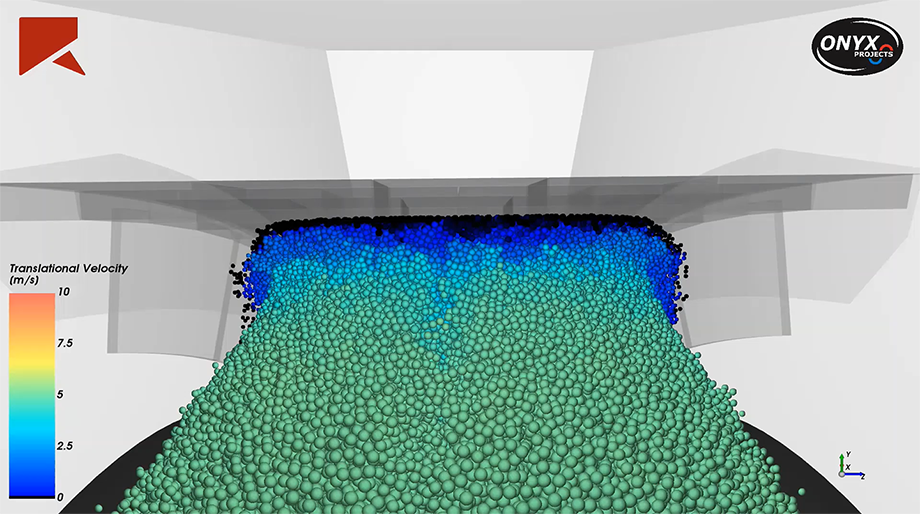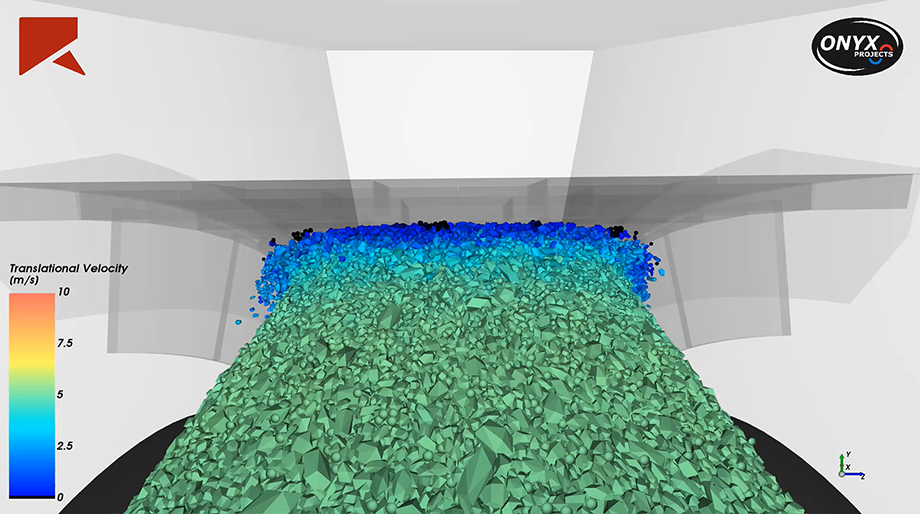Bulk materials clients that routinely handle “sticky” iron-ore fines report that these materials commonly cause problems in transfer chutes, resulting in delays and lost production: material build-up that requires frequent hosing, blocked chutes, non-central loading that leads to belt run-off/drift delays, and material boiling on impact plates that leads to spillage.
In an effort to identify viable solutions, Onyx Projects engineers turned to Rocky DEM discrete element modeling to definitively predict iron-ore fines’ flow behaviour. The calibration/validation package in Rocky DEM helps engineering teams conduct representative material flow simulations that produce accurate results — the most challenging, and important, part of pre-simulation.
The team determined that the process would entail three steps:
- The test should demonstrate the desired flow behaviour.
- Calibration should entail simulating a real-life experiment and adjusting simulation input parameters to match the results of simulation to real-world test.
- The simulation procedure should match the test procedure.
Quantifying Sticky Fines Flow Behavior
Cohesive bulk solids (such as sticky iron-ore fines) can develop sufficient strength to form a stable cohesive arch, a phenomenon commonly associated with bins and hoppers, and less often with transfer chutes, that handle wet, sticky iron-ore fines. Fines flow properties are routinely tested in shear cells, measuring the stress at which the material yields (flows) over a range of consolidation pressures. To perform the final step of calibration/validation, contact parameters (friction coefficient, rolling resistance, adhesion) are adjusted to achieve a match to bench-tested flow properties.
“Our client work relies on the advanced capabilities of Rocky DEM software and the speed of its GPU-powered solver. Engineers calibrate material flow behavior through simulating lab-based flow property tests. Material model behavior is then carefully validated with full-scale chute simulations that we directly compare to site observations of flow and wear patterns.”
– Dr. Richard Elliott
Principal Mechanical Engineer
Onyx Projects
In general, shear cell testing produces measurements that describe handleability of different bulk materials. The tests identify the interface between reliable flow and possible limiting or no-flow conditions. From this data, a wide variety of parameters can be obtained, including the yield locus representing the shear stress to normal stress relationship at incipient flow, angle of internal friction, unconfined yield strength, cohesion, and a variety of related parameters such as flow function.
For cohesive materials, the yield locus is dependent on the normal stress applied during pre-shear.
Typically, three or more normal stresses are tested to produce a family of instantaneous yield loci.
For transfer chute applications, the normal bulk material loads are typically much lower than for storage bins or stockpiles. When reviewing lab shear cell test results, low consolidation (below 10kPa) flow properties are particularly relevant.

Onyx engineers used the Jenike shear cell test method.
Pre-consolidation: A representative sample of material is placed in the shear cell and is pre-consolidated by twisting the shear cell cover while applying a compressive load normal to the cover.
Pre-shear: A normal load is applied to the cover and the sample is pre-sheared until a steady-state shear value is reached.
Shear: The shear stress is removed, and the normal load is reduced before the sample is sheared again, until the shear force reaches a maximum value and then begins to decrease.
The material in the DEM simulations contacts the impact plate at the same height as the observations on site. There is slight boiling at the impact plate in the observations on site, which has been replicated in simulations. DEM simulation shows material stuck to the impact plate in the same places as the observations on site.
Typical flow properties test reports do not contain details of the pre-consolidation stage — the normal load applied and the number of twisting cycles performed.
For dry materials, the pre-consolidation load is typically the same as the pre-shear normal load. However, for cohesive materials to achieve “critical consolidation,” it is often necessary to use a pre-consolidation load many times greater than the normal load used during pre-shear.
To achieve critical consolidation during the DEM simulation of cohesive materials, fill the shear cell without adhesion between particles. Then apply adhesion before the twisting consolidation stage.
Problem
Sticky iron-ore fines commonly cause flow problems within transfer chutes. Capturing this complex behavior in the simulation environment is a major challenge. The resolution was to determine what physical lab tests are appropriate for the calibration/validation of sticky fines, and what site observations could assist with DEM parameter validation.
Solution
Onyx provides value to their clients in the design and development of optimised engineered solutions that have been thoroughly virtually tested and validated. This is achieved via reliable and accurate DEM simulations using Rocky to capture real flow behavior and real flow problems.
Benefit
Clients processing sticky iron-ore fines can expect fewer problems in transfer chutes, reducing material build-up, blocked chutes, belt run-off/drift delays, material boiling on impact plates, and spillage.
Lessons Learned
Does increasing friction coefficients and adhesion parameters result in a drop in shear force? Critical consolidation was not achieved. It needs to be checked for every simulated shear cell test.
Simulation parameters carefully calibrated to instantaneous wall friction shear cell tests did not match site-observed material behavior.
The instantaneous wall friction test procedure has the wall sample in continuous motion, so it does not allow calibration of static friction coefficient; the time consolidation procedure might be more relevant.
Lab test reports often provide extrapolated values of flow function or flow index that cannot be re-created.
About Onyx Projects
Onyx Projects is a project management and engineering company developing and executing projects for the resources and infrastructure sectors. Its four founding directors have a combined experience of more than 100 years delivering greenfield and brownfield projects in mining and minerals processing, iron and steel, petrochemicals, oil refining, chemicals, manufacturing and water treatment facilities in Asia, Australasia, Europe, North America and South America.
Want more information?
If you would like more information on this topic, watch the 30 minute on-demand webinar below that explores materials calibration within Rocky DEM with real word examples from Dr Richard Elliot, Principal Mechanical Engineer, Onyx Projects.





